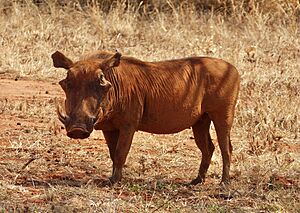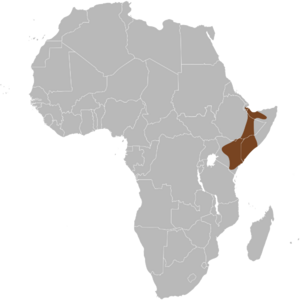Desert warthog facts for kids
Quick facts for kids Desert warthog |
|
|---|---|
 |
|
| P. aethiopicus delamerei | |
| Conservation status | |
| Scientific classification | |
| Genus: |
Phacochoerus
|
| Species: |
aethiopicus
|
| Subspecies | |
|
†P. a. aethiopicus (Pallas, 1766)
|
|
 |
|
The desert warthog (Phacochoerus aethiopicus) is a type of wild pig. It belongs to the pig family, called Suidae. You can find these animals in northern Kenya and Somalia. They might also live in Djibouti, Eritrea, and Ethiopia.
The desert warthog is known for its unique look. It has a flattened head and special bumps, or "warts," on its face. It also has large, curving tusks. These animals are related to the more common common warthog.
| Top - 0-9 A B C D E F G H I J K L M N O P Q R S T U V W X Y Z |
What Makes Desert Warthogs Special?
Desert warthogs are sturdy animals. They usually grow to about 125 centimeters (49 inches) long. Males are bigger, weighing around 75 kilograms (165 pounds). Their bodies have thin, bristly hair. A thicker line of hair runs along their spine, forming a crest.
Their Unique Face and Tusks
The most noticeable features are their facial "warts" and tusks. These "warts" are not really warts. They are thick skin growths. They help protect the warthog's face when it fights. Young warthogs don't have tusks, but they grow over a few years. Male tusks are usually larger than female tusks.
Desert warthogs have a long, thin tail. It ends with a small brush of coarse hair. Their color is usually a medium to dark brown. Sometimes, their crest of hair is whitish.
How They Differ from Other Warthogs
You can tell a desert warthog from a common warthog by a few things. Desert warthogs have ear tips that curl back. They also don't have front teeth (incisors) in their lower jaw. Their snout is generally larger. The areas below their eyes are swollen, forming pouches. These pouches can extend to the base of their facial warts. Common warthogs don't have these swollen areas. Desert warthogs also have more hooked "warts" and a more egg-shaped head.
Where Desert Warthogs Live
The desert warthog comes from the Horn of Africa. Today, they live in southeastern Ethiopia, western Somalia, and eastern and Central Kenya.
Past Homes and Preferred Places
A type of desert warthog, called the Cape warthog, used to live in South Africa. But this group became extinct around 1871.
Desert warthogs like open, dry areas. This includes thin woodlands with scattered trees. They also live in dry scrubland and sandy plains. They do not live in high mountain areas. They need to be near waterholes. So, you might find them close to villages or places where water comes to the surface in dry areas.
How Desert Warthogs Behave
Desert warthogs live in social groups called "sounders." These groups mostly consist of females and their young. Males often live alone or in small groups with other males.
Their Daily Life and Home
A sounder uses a home area of about 10 square kilometers (4 square miles). This area usually has a water hole in the middle. Warthogs dig many burrows, or they use holes dug by other animals. They move between these burrows. If two groups' areas overlap, they might even share the same burrow at different times. But the groups usually don't interact much.
Desert warthogs are active during the day. They mostly eat plants. They look for grasses, leaves, flowers, and fruit. They use their snouts and tusks to dig up roots, tubers, and bulbs. If food is scarce, they will eat insects. They might even eat dead animals. Sometimes, they eat dung, even their own. They also tear bark from trees.
Raising Their Young
Female warthogs can have babies during the breeding season. This usually happens between March and May, after the rainy season. They give off scents that tell males they are ready to mate.
A mother warthog is pregnant for about 170 days. She usually gives birth to two or three piglets in a burrow. The young start coming out of the burrow for short times when they are about three weeks old. As they grow, they stay close to their mother. They stop drinking milk at three months or more. But they still depend on their mother for several more months.
Their mother protects them from animals that hunt them. These predators include lions, leopards, cheetahs, and hyaenas. Desert warthogs have special grunts to warn their group of danger. They might freeze at first, then run away quickly. They can run up to 55 kilometers (34 miles) per hour to reach a safe burrow. Young warthogs dive into the burrow headfirst. Older warthogs back into the burrow. This way, they can use their tusks to defend themselves. Young warthogs become adults at one to one and a half years old. They can live for ten years or more.
Researching Desert Warthogs
Scientists study desert warthogs for many reasons. They learn about their health and how they interact with their environment. For example, research has shown that warthogs can carry certain viruses without getting sick themselves. This helps scientists understand how diseases spread among animals.
Scientists also study warthogs because they can be hosts for insects like the tsetse fly. The tsetse fly can carry diseases. Understanding how warthogs interact with these flies helps manage animal health in the region.
Warthogs have many babies, so researchers also study their breeding habits. This helps them understand how warthog populations grow. This information can be used to decide the best ways to manage their numbers.
Desert Warthog Status
The International Union for Conservation of Nature (IUCN) keeps a list of endangered species. They have listed the desert warthog as "Least Concern." This means they are not currently in danger of extinction.
Why They Are Not Endangered
Desert warthogs are common in some areas where they live. Their population is thought to be stable. They live in many national parks and wildlife areas. They don't face many big threats. Sometimes, they are hunted for meat in local areas. They also compete with farm animals for water and grazing land.


